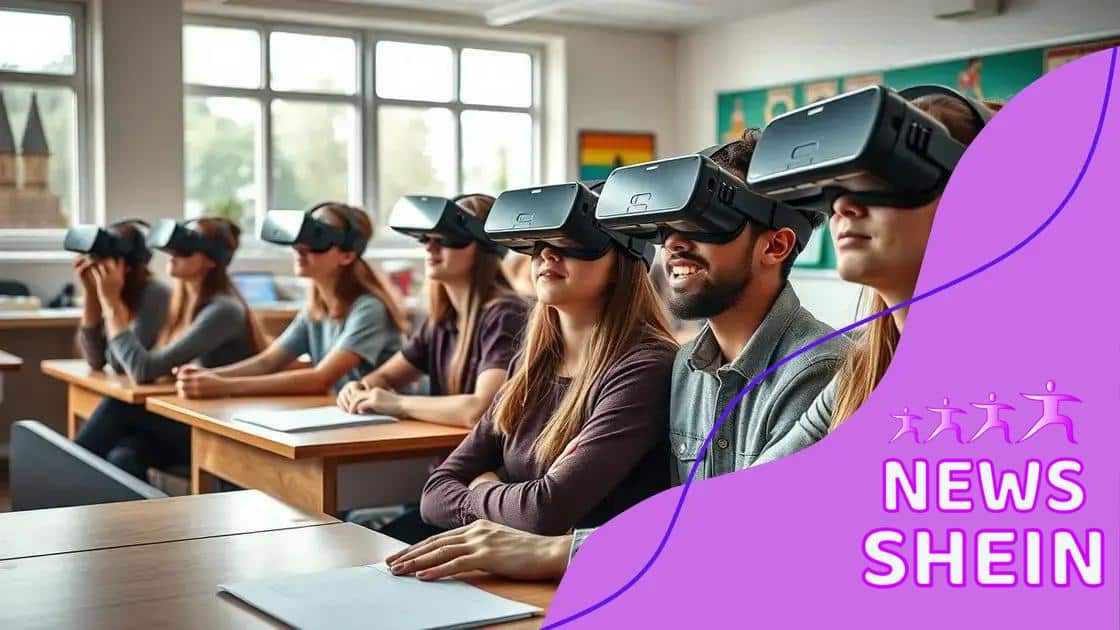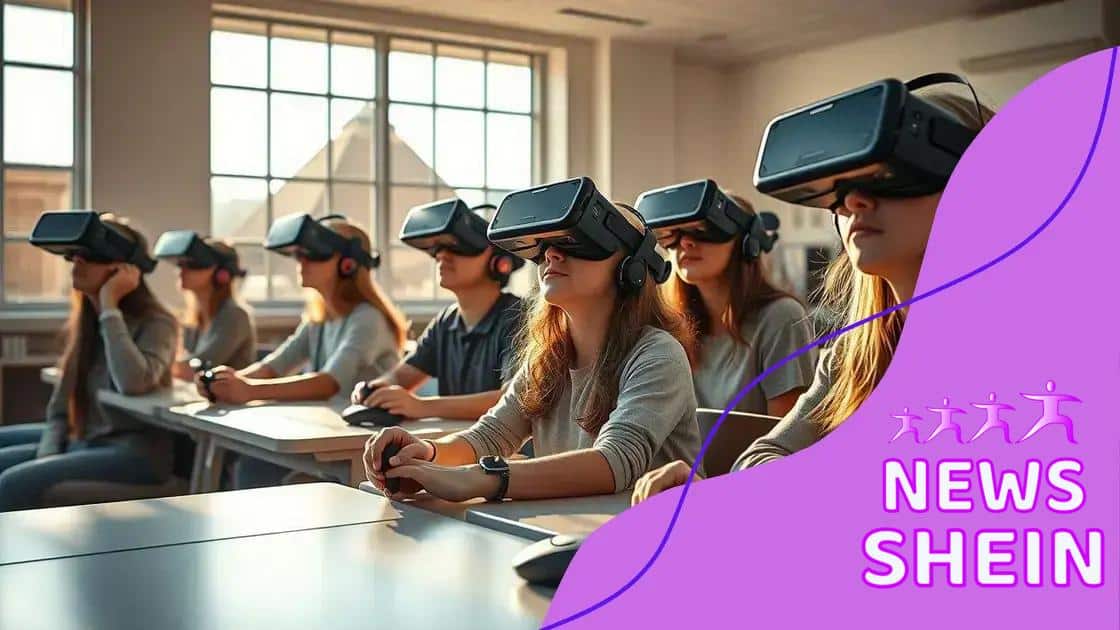Using virtual reality to teach history and social sciences

Using virtual reality to teach history and social sciences enhances student engagement through immersive experiences, making complex topics more relatable and fostering a deeper understanding of cultural heritage.
Using virtual reality to teach history and social sciences opens up exciting possibilities for educators today. Have you ever imagined walking through ancient civilizations or exploring significant social movements right from your classroom? This article dives into how VR can transform the way we learn.
The benefits of virtual reality in education
Virtual reality (VR) is changing how we approach education by enhancing engagement and retention among students. By allowing learners to interact with immersive environments, VR transforms traditional learning into an exciting experience.
One major benefit of VR in education is its ability to provide experiential learning opportunities. This hands-on experience can lead to better understanding and memory retention. For example, students can virtually explore historical sites or scientific phenomena without leaving their classrooms.
Engagement and Motivation
Another key advantage is that VR increases student motivation. The novelty of using virtual reality can capture interest and make learning feel less like a chore. When students are excited to participate, they are more likely to engage with the material.
- Interactive simulations keep learners interested.
- Experiences can feel more relatable and enjoyable.
- It encourages active participation rather than passive listening.
Furthermore, VR can accommodate diverse learning styles. Whether students learn best through visual, auditory, or kinesthetic means, virtual environments can be tailored to meet these needs. This flexibility makes it easier for educators to reach all students.
Accessibility
The use of VR can also enhance accessibility. Students with disabilities might face challenges in traditional learning environments, but VR can provide alternative ways to interact with content.
- Students can experience field trips virtually, regardless of physical limitations.
- Customization options achieve personalized learning experiences.
- It connects students with resources that might be otherwise unavailable.
By incorporating virtual reality into education, teachers can create unforgettable learning experiences. These immersive lessons can spark curiosity and foster deeper connections to the subjects studied, paving the way for lifelong learning.
Engaging students through immersive experiences
Engaging students through immersive experiences is one of the most powerful benefits of virtual reality (VR) in education. With VR, learners can dive into interactive worlds that captivate their interest and spark curiosity.
When students wear VR headsets, they feel as if they are truly part of the historical events or social scenarios being studied. This level of engagement can lead to better retention of information, as they are not just passive recipients of knowledge.
Active Learning
Active learning is key to educational success. VR allows students to participate actively in their learning journey. Instead of simply reading about a concept, they can experience it firsthand. This method encourages critical thinking and problem-solving skills.
- Students can make decisions in a simulated environment.
- They learn by doing, which reinforces understanding.
- Students can reflect on their experiences and share insights with peers.
Furthermore, immersive VR experiences can cater to diverse interests. For instance, a history lesson might take students through a virtual tour of ancient Rome, while a science class could involve exploring the cells of a plant. These captivating experiences provide varied contexts that resonate with different learning styles.
Social Interaction
Another significant feature of VR is the ability to connect with peers in a virtual setting. Students can collaborate on projects or explore shared environments together. This shared experience enhances social learning opportunities, making education a more community-oriented process.
- Collaborative VR activities foster teamwork.
- Students can communicate in real-time through avatars.
- Group problem-solving becomes more engaging and interactive.
Engaging in such immersive experiences not only makes learning more enjoyable but also prepares students for the future. They develop skills necessary for an increasingly digital world. Overall, the integration of VR in education offers a vibrant platform for engagement and a deeper appreciation of complex subjects.
Practical applications of VR in history lessons

Practical applications of VR in history lessons provide students with memorable and engaging experiences. By immersing learners in historical events and environments, educators can foster a more profound understanding of past societies and cultures.
One popular application is virtual field trips. Students can visit historical landmarks across the globe without ever leaving their classroom. Imagine walking through the streets of ancient Athens or exploring the pyramids of Egypt as if you were really there. This not only brings history to life but also makes it much more relatable.
Simulations of Historical Events
Another way to utilize VR is through simulations of significant historical events. Students can actively participate in scenarios such as the signing of the Declaration of Independence or the storming of the Bastille. This type of interactive learning invites deeper emotional connections to the material.
- Students develop empathy by stepping into the shoes of historical figures.
- Experiences can highlight the complexities of historical decisions.
- Engaging with events fosters critical thinking about the causes and effects.
Additionally, role-playing in these simulations allows for collaborative learning. Students can work together, debating and discussing different perspectives on historical events. This teamwork enhances their communication and social skills.
Enhancing Research Skills
VR isn’t just about experience; it can also support research skills. Students can use VR technology to access vast archives and databases related to their studies. This exposure teaches them how to find credible sources and analyze information effectively.
- Students can explore artifacts from different cultures in 3D.
- Historical documents can be examined in detail.
- Virtual tools help visualize complex historical data.
In summary, the use of virtual reality in history lessons enables educators to create powerful learning experiences. By making history interactive and accessible, students are more likely to develop a lasting interest in the subject.
Exploring cultural heritage with virtual tours
Exploring cultural heritage with virtual tours allows students to connect deeply with history and tradition. These immersive experiences enable learners to visit cultural landmarks and understand significant historical contexts without the constraints of distance.
One of the key advantages of using VR for cultural exploration is access to places that might be physically unreachable. Students can take virtual journeys to museums, archaeological sites, and historical cities from their classrooms. This accessibility broadens their perspective on global cultures.
Immersive Experiences
During virtual tours, students can interact with replicas of artifacts or explore digital reconstructions of historical sites. This hands-on approach encourages them to ask questions and engage in discussions about what they see. VR provides a sensory-rich environment that enhances learning.
- Visitors can walk through ancient ruins or visit art galleries.
- They can engage with multimedia content about the culture or site.
- Live guides may enhance experiences with real-time insights.
In addition to visual experiences, virtual tours can include auditory elements. Sounds from the environment, such as local music or the chatter of a busy market, can make the experience feel more authentic. This sensory engagement fosters emotional connections to the cultural heritage being studied.
Cultural Understanding
These tours help students appreciate diverse cultures and histories. By exploring what others have created and valued throughout time, learners can better understand societal differences and similarities. This understanding can cultivate respect and empathy.
- Students learn about traditions and practices different from their own.
- They can discover the significance of historical events in various cultures.
- Virtual experiences challenge stereotypes and encourage open-mindedness.
Ultimately, exploring cultural heritage through virtual tours enriches education by making history alive and relevant. It prepares students to be informed global citizens with a greater appreciation for the world’s diversity.
Challenges and future of VR in social sciences
Challenges and the future of VR in social sciences present both obstacles and exciting opportunities for educators and students alike. As technology evolves, the incorporation of VR into the curriculum faces several hurdles that must be addressed.
One primary challenge is the cost of VR technology. Setting up VR systems in classrooms can require significant investment in hardware and software. Many schools may struggle to find the funds needed for these advancements. This can create disparities in access, as not all students may benefit from the same immersive experiences.
Training and Familiarity
Another challenge centers on the need for proper training. Teachers must become familiar with VR tools and how to integrate them into their lessons. Without adequate training, educators may feel overwhelmed or unsure about using this technology effectively. Professional development programs are essential to prepare teachers for this shift.
- Educators need time to learn how to use VR settings.
- Training should cover lesson planning with VR.
- Support from experienced users can guide new adopters.
Despite these challenges, the future of VR in social sciences looks promising. As technology advances, VR applications will become more affordable and accessible, leading to broader implementation in classrooms. This evolution can facilitate greater engagement and interest in social studies.
Enhanced Learning Experiences
Looking ahead, VR has the potential to revolutionize how students understand complex social issues. For example, VR can simulate real-world scenarios, allowing students to experience social dynamics firsthand. These immersive experiences can bridge the gap between theory and practice.
- Students can analyze political systems in virtual environments.
- They can understand the effects of social policies through simulations.
- Role-playing different perspectives can enhance empathy and understanding.
Overall, while there are obstacles to overcome, the future of virtual reality in social sciences is bright. By addressing challenges and investing in this technology, educators can create dynamic learning environments that enrich students’ educational journeys.
FAQ – Frequently Asked Questions about Using Virtual Reality in Education
What are the main benefits of using VR in social sciences?
The benefits include enhanced student engagement, improved understanding of complex topics, and the ability to connect with diverse cultures through immersive experiences.
What challenges do educators face when implementing VR?
Challenges include high costs of technology, the need for proper training for teachers, and varying access for students in different schools.
How can VR help students understand cultural heritage?
VR allows students to take virtual tours of historical sites and explore artifacts, providing a more engaging way to learn about different cultures and histories.
What does the future hold for VR in education?
The future looks promising, with advancements in technology making VR more affordable and accessible, leading to innovative applications in classrooms.






